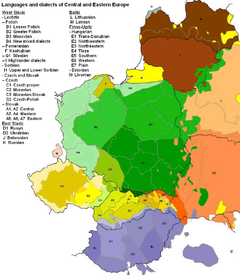
Masovian dialect
Encyclopedia
- This is a sub-article to Dialects of the Polish languageDialects of the Polish languageIn Polish linguistic tradition there are seven general dialectal groups of the Polish language, each primarily associated with a certain geographical region...
Mazovian (Masovian) dialects of the Polish language
Polish language
Polish is a language of the Lechitic subgroup of West Slavic languages, used throughout Poland and by Polish minorities in other countries...
are characteristic of Mazovia
Mazovia
Mazovia or Masovia is a geographical, historical and cultural region in east-central Poland. It is also a voivodeship in Poland.Its historic capital is Płock, which was the medieval residence of first Dukes of Masovia...
and historically related regions, in northeastern Poland. They are the most distinct of Polish dialects and the most expansive.

Mazurzenie
Mazurzenie or mazuration is the replacement or merger of Polish's series of retroflex fricatives and affricates into the alveolar series...
, liaison
Liaison
Liaison in general means:# Communication between two or more groups.# Co-operation, working together.but may refer to:* Affair, an unfaithful or adulterous sexual relationship* Air Alliance, a Canadian airline whose call sign was "Liaison'...
(nieudźwięczniająca) (ubezdźwięcznienie) consonants before vowels in nagłosie next word), and asynchronous palatal pronunciation of labial consonants (softened). The Kurpie
Kurpie
Kurpie is one of a number of ethnic regions in Poland, noted for its unique traditional customs, such as its own types of traditional costume, traditional dance, and distinctive type of architecture and livelihoods...
region has some of the most distinctive phonetic features due to isolation. Characteristics include:
- ke, ge → kie, gie; kę, gę → ke, ge (e.g. nogie, rękie, kedy, kerować);
- No palatalizationPalatalizationIn linguistics, palatalization , also palatization, may refer to two different processes by which a sound, usually a consonant, comes to be produced with the tongue in a position in the mouth near the palate....
of L (e.g. lytr, lysa, lymuzyna); - the instrumentalInstrumental caseThe instrumental case is a grammatical case used to indicate that a noun is the instrument or means by or with which the subject achieves or accomplishes an action...
plural formGrammatical numberIn linguistics, grammatical number is a grammatical category of nouns, pronouns, and adjective and verb agreement that expresses count distinctions ....
–mi is pronounced –my; - developed gumline consonants: sz, ż, cz, di w s, z, c, dz
- harder pronunciation in the frontal position: instead of lipa -> lypa
- -oju ending in masculine singular Dative
- change of y into i: dim, ribi, sin, bik, if its followed by a consonant, the consonant remains hard
- the double-number -wa ending remains in use in plural verbs relating to plural,
- no difference between soft and hard k ang g, including ki i gi, ch in chy is always soft while in che or chę it is not always the case;
- e and o are pronounced as a joint sound of e with i and o with u
- nasal vowels developed as u instead of ą and a instead of ę;
- -eli ending in plural of the past tense
- change of a into e in words: beginning with ra-, ja-, -ar- in the middle of a word -ar- in past verb tenses. Also, in words such as powjedać, wjetrak, zawjesy, śnijedańe;
- accomplished articulating of the following consonants: p, b, w, f, m into pj, bj, wj, fj, mj or pś, bź, wź, fś sometimes simplicised into ńasto "miasto", kańeń "kamień" (ona) ńała "miała" which is changed at times for soft n. In company with lip consonants the following forms are common: śfyńa, śfat, śfeca, ćfartka, ńedźweć, -amy in plural instrumental case and in pronouns like me "mnie" and my "mi"
Masovian dialects also contain certain vocabulary that is distinct from the standard Polish language.
Subdialects
Mazovian dialects include but are not limited to subdialects (gwaras of:- Białystock dialect
- Suwałki dialect
- Warmia dialect
- Kurpie dialect
- Masurian dialect
- Malbork-Lubawa dialect
- Ostróda dialect
- Near Mazovian dialect
- Far Mazovian dialect
- Warsaw dialectWarsaw dialectThe Warsaw dialect is a regional dialect of the Polish language spoken in Warsaw. The dialect evolved as late as 18th century, mainly from the Masovian dialect of the Polish language, under notable influence of several languages spoken in the city of Warsaw...

